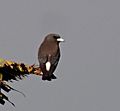White-breasted woodswallow facts for kids
Quick facts for kids White-breasted woodswallow |
|
|---|---|
 |
|
| Conservation status | |
| Scientific classification | |
| Genus: |
Artamus
|
| Species: |
leucorynchus
|
The white-breasted woodswallow (Artamus leucorynchus) is a medium-sized passerine bird, which means it's a type of songbird. These birds live and breed from the Andaman Islands all the way east through Indonesia and northern Australia.
Even though they are called "woodswallows," they are not closely related to true swallows. Instead, they belong to a bird family called Artamidae. This family also includes birds like butcherbirds, currawongs, and the Australian magpie.
Contents
About the White-breasted Woodswallow
The white-breasted woodswallow was first officially described by a scientist named Carl Linnaeus in 1771. Its scientific name, leucorynchus, comes from ancient Greek words. Leukos means 'white' and rhynchos means 'bill'. This name perfectly describes one of their main features!
There are nine different types, or subspecies, of the white-breasted woodswallow. They live in various places across Asia and Australia. These subspecies are very similar but have small differences in their color, size, and bill shape.
What Does a White-breasted Woodswallow Look Like?
The white-breasted woodswallow has dark grey feathers on its head and neck. Its belly and chest are bright white. This white underside is how it got its name!
Their strong beak is bluish-grey with a black tip. They also have a short, black tail and grey feet. Interestingly, they are the only woodswallow that has a completely black tail, without any white markings.
Both male and female woodswallows look exactly the same. Young woodswallows, called juveniles, look a bit different. They have brownish feathers on their head and back, often with stripes. Their chest might have a light brown tint, and their beak is brownish with a dark tip.
These birds can grow up to about 18 centimeters (7 inches) long. They usually weigh between 35 and 45 grams, which is about the same as a few strawberries.
Where They Live and How They Reproduce
White-breasted woodswallows live in many different places across Australia and nearby islands. You can find them in forests, open woodlands, and even dry plains. They like areas with a mix of plants, including shrubs, mangrove trees, and grassy spots. They are often found near water.
These birds usually live from sea level up to about 1,500 meters (almost a mile high). Some groups of woodswallows move around. Birds from southern areas fly north during autumn and then return south in the spring.
Breeding and Nests
The time when white-breasted woodswallows breed changes depending on where they live. In warmer northern areas, they usually breed between March and May. In southern areas, breeding happens between August and January, often before or during the wet season.
When a female woodswallow is ready to mate, she performs a special dance. She spreads her wings over her back in a 'V' shape and trembles them towards a male. She also wiggles her tail and makes a soft 'eep' sound.
White-breasted woodswallows are known as cooperative breeders. This means that other birds, not just the parents, help take care of the young. Both male and female birds work together to build the nest, sit on the eggs, and feed the baby birds.
Their nests are shallow and shaped like a bowl. They build them using grass, small twigs, and roots, and then line them with soft, fine grass. Nests are often placed in the forks of trees or inside hollow tree stumps. Sometimes, they even reuse old nests built by other birds like magpie larks!
A female woodswallow usually lays between 2 and 5 eggs. The eggs are oval-shaped and are cream or pinkish in color, with darker brown speckles. After the eggs are laid, they are kept warm for about 15 days until they hatch.
What They Eat and How They Behave
White-breasted woodswallows have a special tongue that is split at the end and has a brush-like tip. This type of tongue is usually found in birds that drink nectar from flowers. However, woodswallows are mostly insectivores, meaning they eat insects.
They catch most of their food, like insects, while flying. They are very good at catching insects in mid-air or by swooping down from a perch. Sometimes, they also eat nectar from flowers. They might also look for food on the ground or in the tops of trees. If they catch a very large insect, they might share it with other birds in their group.
Flying and Social Life
These woodswallows have large, pointed wings and are amazing flyers. They are very quick and can glide easily. They are one of the few songbirds that can soar high in the sky.
Even though they are small, white-breasted woodswallows can be quite brave and protective of their territory. Groups of them will sometimes chase away larger birds if they feel threatened.
When it's not breeding season, woodswallows often move around a lot, following groups of flying insects. They like to gather in large groups, called flocks, to rest. You can usually see them in flocks of 10 to 50 birds, but sometimes there can be as many as 100 birds together.
In the evenings, flocks often gather closely together to roost (rest). Woodswallows are very social birds. They are well-known for huddling tightly together on a branch or powerline. This behavior helps them stay warm and save energy.
Conservation Status
The white-breasted woodswallow lives in a very large area and has a stable population. This means there are many of them, and their numbers are not decreasing. Because of this, they are listed as a species of "Least Concern" by conservation groups. There is no worry that they will become endangered.
Images for kids
See also
 In Spanish: Artamo ventriblanco para niños
In Spanish: Artamo ventriblanco para niños




